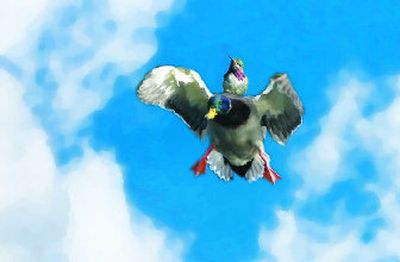Bird migration myth a real humdinger

Have you ever wondered how our smallest birds, the hummingbirds, are able to migrate thousands of miles between their nesting grounds here in the Northwest and their wintering grounds as far away as South America?
The birds are so small and fragile, their wings and hearts beat so rapidly, and that’s such a great distance to travel – how can they possibly do it? The very idea is staggering.
The thing that makes the concept of intercontinental migration by these little birds seem so improbable to me is the way their bodies are stressed during just an average day.
The hummingbird we know the most about is the ruby-throated hummingbird of the eastern United States. It takes eight hummers to weigh an ounce, and in normal daily flight, their hearts will beat 1,000 times a minute (17 beats per second) and their wings will flap 4,800 times a minute (80 per second).
They are so small and burn energy at such a fantastic rate that when not out foraging for food, nectar or sugar water, and especially in the cool of night, they go into a torpor that shuts them down in much the way hibernating species shut down on a seasonal basis. Their body temperature may drop from 110 degrees to 50 degrees and their heart rate may slow to 50 beats per minute.
So again, the question is: How do they ever accomplish their twice-yearly trip to the tropics?
I had always considered some of the explanations I had heard as folklore or myth – although no less probable than the idea of these tiny birds actually flying all that distance on their own. The main means of transport that I have heard suggested is that they ride on the backs of larger birds.
There long has been speculation – but no proof – that hummingbirds ride on vultures during their incredible migrations. Vultures are large with gentle soaring flight. Hummingbirds have small, weak feet, so I was never certain how they could hold on, but such a trip was relatively easy to imagine. Many people know it to be a fact. I have had questions asked about it many times.
Now, however, there is photographic proof that waterfowl provide the transport vehicle for hummingbirds. Ducks are well-known for their incredible migrations, so it should come as no surprise that hummingbirds rely upon them. With the hummingbirds’ light weight, I doubt the ducks even know they are there. I still, however, do not understand how the hummers hold on with their small feet.
Are you still with me here? Are you buying all this? Is it the number of heart and wing beats that you are having trouble believing, or is it the birds’ metabolic abilities? Actually, all those are documented. It’s the picture that’s a phony, yet the details of hummingbird migration just keep getting more and more unbelievable.
In the case of the ruby-throated hummer, its migration trip may include a 60 mph nonstop flight across more than 500 miles of open water over the Gulf of Mexico. There are no rest or refueling stops along the way. The birds will, in fact, double their weight just prior to migration to have enough onboard fuel – fat – for the journey.
So, as amazing as it seems, hummingbirds actually do travel all those miles, from here to there and back, each year on their own. I guess those little feet really can’t hold on, especially when a mallard makes an explosive takeoff.
So, keep in mind that you can’t believe everything you hear or see, even if you see it for yourself. Also realize that in the wild, fact often is more amazing than fiction.